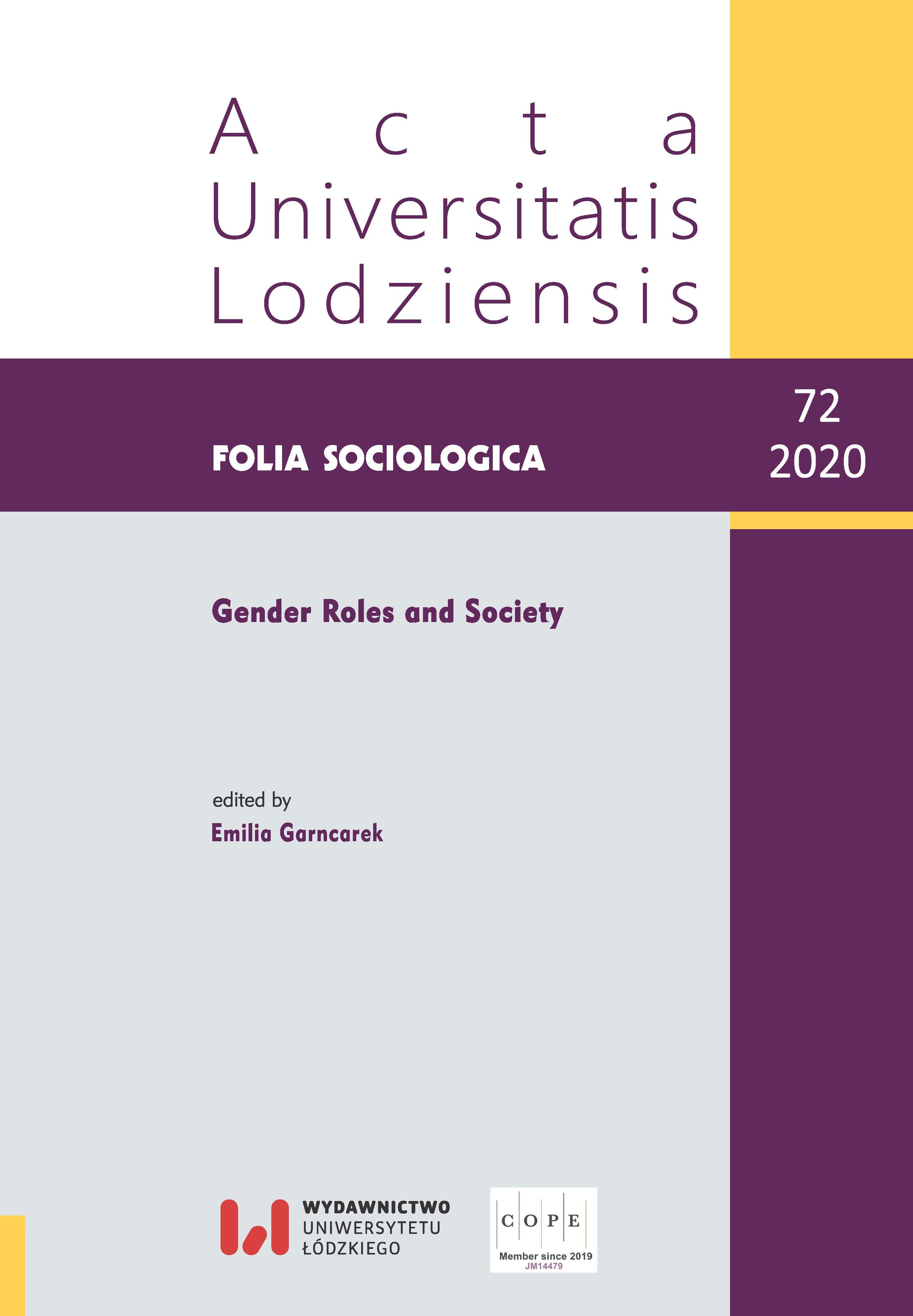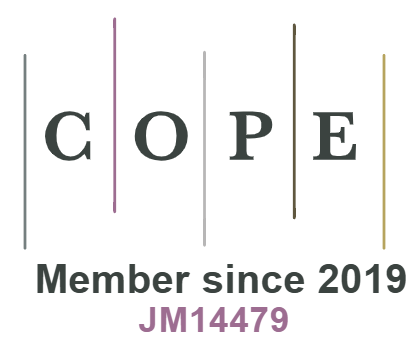Which women (don’t) leave and which men (don’t) stay? Gender and the diversity of forms and the temporality of contemporary intimate relationships
DOI:
https://doi.org/10.18778/0208-600X.72.01Keywords:
intimate relationships, breakups, women, men, sex, genderAbstract
The article focuses on relationship experiences in the light of the diversity of relationship forms, relationship length and the attitude of partners to relationship permanence. The conceptual framework was determined by the sociotemporal perspective, and the analysis was carried out with reference to concepts employed in the fields of the sociology of the family, the sociology of intimacy, the sociology of gender and the sociology of time. The aim of the study was to determine the relationship between the socio-demographic characteristics of women and men and their relationship experiences, the diversity of relationship forms and their length, as well as their readiness to stay in a relationship or leave in a crisis situation. The research was carried out using the diagnostic survey method on a representative sample of adult Poles in January 2018. Gender has been shown to differentiate the length of relationship and the attitudes to relationship permanence. It was found that women stay in shorter relationships more often than men. It was also found that the experiences of women with different types of relationships are more diverse when linked to their social status than the experiences of men. Four types of orientation to the (im)permanence of relationships were identified. It was established that men’s readiness to leave depends on their age, education and self-assessment of their financial situation, whereas women’s decision to leave depends on their age, education and socio-occupational category.
References
Acker J. (1990), Hierarchies, Jobs, bodies: A Theory of Gendered Organizations, “Gender & Society”, no. 2, pp. 139–158.
Google Scholar
Adamski F. (2002), Rodzina. Wymiar społeczno-kulturowy, Wydawnictwo Uniwersytetu Jagiellońskiego, Kraków.
Google Scholar
Afifi T., Davis S., Denes A., Merrill A. (2013), Analyzing divorce from cultural and network approaches, “Journal of Family Studies”, vol. 19, no. 3, pp. 24–53.
Google Scholar
Amato P.R. (2000), The Consequences of Divorce for Adults and Children, “Journal of Marriage and Family”, vol. 62, no. 4, pp. 1269–1287.
Google Scholar
Bauman Z. (2003), Liquid Love: On the Frailty of Human Bonds, Polity Press, Cambridge.
Google Scholar
Bawin-Lergos B. (2004), Families in Europe: A private and Political Satake – Intimacy and Solidarity, “Current Sociology”, vol. 49, no. 5, pp. 49–65.
Google Scholar
Beck U., Beck-Gernsheim E. (1995), The Normal Chaos of Love, transl. M. Ritter, J. Wiebel, Polity Press, Cambridge.
Google Scholar
Beck-Gernsheim E. (2002), Reinventing the Family. In Search of New Lifestyles, Polity Press, Cambridge.
Google Scholar
Brown S.L. (2004), Moving from cohabitation to marriage: effects on relationship quality, “Social Science Research”, vol. 33(1), pp. 1–19.
Google Scholar
Collier J.F., Rosaldo M.Z., Yanagisako S. (2007), Czy rodzina istnieje? Nowe ujęcia antropologiczne, transl. A. Ostrowska, [in:] R.E. Hryciuk, A. Kościańska (eds.), Gender. Perspektywa antropologiczna, Wydawnictwo Uniwersytetu Warszawskiego, Warszawa, vol. 1, pp. 60–75.
Google Scholar
Connell R. (1987), Gender and Power: Society, the Person and Sexual Politics, Stanford University Press, California.
Google Scholar
Connell R. (2013), Socjologia płci. Płeć w ujęciu globalnym, Wydawnictwo Naukowe PWN, Warszawa.
Google Scholar
De Singly F. (1994), Fortuna e sfortuna della donna sposata. Sociologia della vita matrimoniale, transl. V. Cicchelli, Edizioni Dedalo, Bari.
Google Scholar
De Singly F. (1996), Sociologia della famiglia contemporanea, Palomar Athenaeum, Bari.
Google Scholar
Dychtwald M. (2003), Cycles. How We Will Live. Work and Buy, Free Press, New York.
Google Scholar
Ferree M.M. (2003), Practice Makes Perfect?: A Comment on Yancey Martin’s Gendering Practices, Practicing Gender, “Gender & Society”, no. 3, pp. 373–378.
Google Scholar
Giddens A. (2006), Przemiany intymności: seksualność, miłość i erotyzm we współczesnych społeczeństwach, transl. A. Szulżycka, Wydawnictwo Naukowe PWN, Warszawa.
Google Scholar
Giddens A. (2007), The Global Revolution in Family and Personal Life, [in:] A.S. Skolnick, J.H. Skolnick (eds.), Family in Transition, Pearson, Boston, pp. 76–95.
Google Scholar
Giddens A. (2010), Nowoczesność i tożsamość: “Ja” i społeczeństwo w epoce późnej nowoczesności, transl. A. Szulżycka, Wydawnictwo Naukowe PWN, Warszawa.
Google Scholar
Hills Ch., Rubin Z., Peplau L. (1976), Breakups Before Marriage: The End of 103 Affairs, “Journal of Socilal Issues”, vol. 32, no. 2, pp. 147–168.
Google Scholar
Holmes J., Marra M. (2011), Leadership discourse in a Maori workplace: negotiating gender, ethnicity and leadership at work, “Gender and Language”, vol. 2, pp. 317–342.
Google Scholar
Illouz E. (2016), Dlaczego miłość rani. Studium socjologiczne, Wydawnictwo Krytyki Politycznej, Warszawa.
Google Scholar
Jalovaara M. (2003), The Joint Effects of Marriage Partners’ Socioeconomic Positions on the Risk of Divorce, “Demography”, vol. 40, no. 1, pp. 67–81.
Google Scholar
Jamieson L. (1998), Intimacy: Personal Relationships in Modern Societies, Polity Press, Cambridge–Malden.
Google Scholar
Jamieson L. (2008), Od rodziny do intymności, [in:] P. Sztompka, M. Bogunia-Borowska (eds.), Socjologia codzienności, Wydawnictwo Znak, Kraków, pp. 115–142.
Google Scholar
Jewdokimow M., Garncarek M. (2007), W pół kroku. Single o sobie samych, “Societas/ Communitas”, no. 4–5(2), pp. 173–194.
Google Scholar
Kaufmann J.C. (1993), Sociologie du couple (4 edition), Presses Universitaires de France, Paris.
Google Scholar
Kaufmann J.C. (2005), Quando l’amore comincia, Societa Editrice il Mulino, Bologna.
Google Scholar
Kaufmann J.C. (2012), Niezwykła historia szczęśliwej miłości, transl. A. Kapciak, Oficyna Naukowa, Warszawa.
Google Scholar
Kiernan K. (2004), Cohabitation and Divorce across Nations and Generations, [in:] P.L. Chase-Lansdale, K. Kiernan, R.J. Friedman (eds.), Human Development across Lives and Generations, University Press, Cambridge.
Google Scholar
DOI: https://doi.org/10.1017/9780511808302.007
Krumrei E., Mahoney A., Pargament K.I. (2009), Divorce and the Divine: The Role of Spirituality in Adjustment to Divorce, “Journal of Marriage and Family”, vol. 71, pp. 373–383.
Google Scholar
Kwak A. (2014), Współczesny świat zmian – alternatywy dla małżeństwa, “Acta Universitatis Lodziensis. Folia Sociologica”, no. 51, pp. 5–19.
Google Scholar
Kwak A., Bieńko M. (eds.) (2012), Wielość spojrzeń na małżeństwo i rodzinę, Wydawnictwa Uniwersytetu Warszawskiego, Warszawa.
Google Scholar
Lahad K. (2011), Singlehood, Waiting, and the Sociology of Time, “Sociological Forum”, vol. 27, no. 1, pp. 163–186.
Google Scholar
Lenz K. (2006), Soziologie der Zweierbeziehung. Eine Einführung, Springer, Wiesbaden.
Google Scholar
Majka-Rostek D. (2008), Związki homoseksualne. Studium socjologiczne, Difin, Warszawa.
Google Scholar
Martin P. Y. (2004), Gender As Social Institution, “Social forces”, vol. 4, pp. 1249−1273.
Google Scholar
Mizielińska J. (2017), Odmienne czy zwyczajne. Rodziny z wyboru w Polsce, Wydawnictwo Naukowe PWN, Warszawa.
Google Scholar
Musiał M. (2015), Intymność i jej współczesne przemiany. Studium z filozofii kultury, Wydawnictwo Universitas, Kraków.
Google Scholar
Paprzycka E. (2019), Biografie intymne singli – analiza typologiczna, [in:] K. Wąż (ed.), Obyczajowość seksualna Polaków. Perspektywa interdyscyplinarna, Oficyna Wydawnicza “Impuls”, Kraków, pp. 135–177.
Google Scholar
Plummer K. (2003), Intimate Citizenship: Private Decisions and Public Dialouges, University of Washington Press, Seattle–London.
Google Scholar
Renzetti C.M., Curran D.J. (2008), Kobiety, mężczyźni i społeczeństwo, Wydawnictwo Naukowe PWN, Warszawa.
Google Scholar
Schmidt F. (2015), Para, mieszkanie, małżeństwo: dynamika związków intymnych na tle przemian historycznych i współczesnych dyskusji o procesach indywidualizacji, Wydawnictwo Naukowe Uniwersytetu Mikołaja Kopernika i Fundacja na rzecz Nauki Polskiej, Warszawa–Toruń.
Google Scholar
Schmidt F., Mizielińska J., Stasińska A., Olcoń-Kubicka M., Żadkowska M., Jasińska J., Halawa M. (2018), W stronę socjologii pary: propozycja paradygmatu teoretyczno-badawczego, “Studia Socjologiczne”, vol. 3(230), pp. 12–39.
Google Scholar
Silverstein L.B., Auerbach C.F. (2005), (Post)modern Families, [in:] J.L. Roopnarine, U.P. Gielen (eds.), Families in Global Perspective, Pearson, Boston, pp. 33–48.
Google Scholar
Slany K. (2001), Alternatywne formy życia małżeńsko-rodzinnego w ponowoczesnym świecie, Zakład Wydawniczy Nomos, Kraków.
Google Scholar
Slany K. (2006), Socjo-demograficzne aspekty “syndromu opóźniania” i jego konsekwencje dla polityki społecznej, “Roczniki Socjologii Rodziny. Studia socjologiczne oraz interdyscyplinarne”, vol. XVII, pp. 13–25.
Google Scholar
Strzelecka C. (2017), Wpływ czasu społecznego na konstruowanie modeli życia rodzinnego, “Tematy z Szewskiej”, no. 219, pp. 7–19.
Google Scholar
Szlendak T. (2011), Socjologia rodziny: ewolucja, historia, zróżnicowanie, Wydawnictwo Naukowe PWN, Warszawa.
Google Scholar
Sztompka P. (2012), Socjologia. Analiza społeczeństwa, Wydawnictwo Znak, Kraków.
Google Scholar
Toffler T. (2007), Szok przyszłości, transl. W. Osiatyński, E. Grabczak-Ryszka, E. Woydyłło, Kurpisz, Warszawa, pp. 206–217.
Google Scholar
Toth K., Kemmelmeier M. (2009), Divorce attitudes around the world: Distinguishing the impact of culture on evaluations and attitude structure, “Cross-Cultural Research”, no. 43, pp. 280–297.
Google Scholar
Trybulec M. (2009), Nowe media a kulturowe doświadczenie czasu. Uwagi krytyczne na marginesie teorii akceleracji czasu, “Annales Universitatis Mariae Curiae-Skłodowska. Sectio I, Philosophia-Sociologia”, no. 34, pp. 7–19.
Google Scholar
Walerstein J., Blakeslee S. (1989), Second Chances: Men, Women, and Children a Decade after Divorce, Ticknor & Fields, New York.
Google Scholar
Wharton A.S. (2006), The Sociology of Gender. An Introduction to Theory and Research, Blackwell Publishing, Malden-Oxford.
Google Scholar
Downloads
Published
How to Cite
Issue
Section
License

This work is licensed under a Creative Commons Attribution-NonCommercial-NoDerivatives 4.0 International License.










